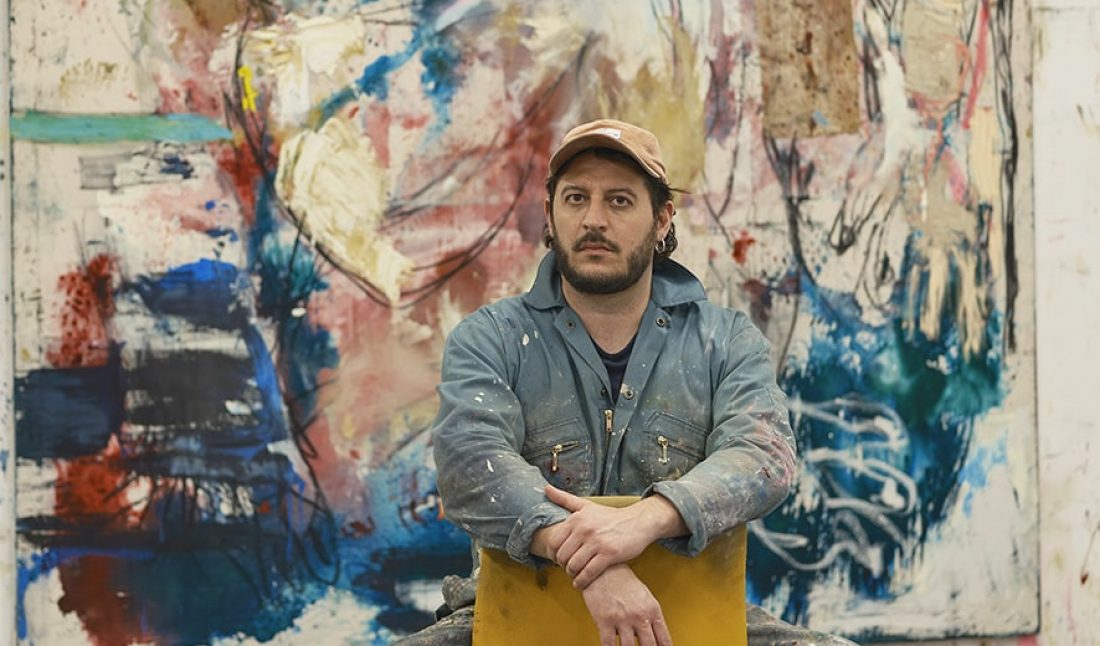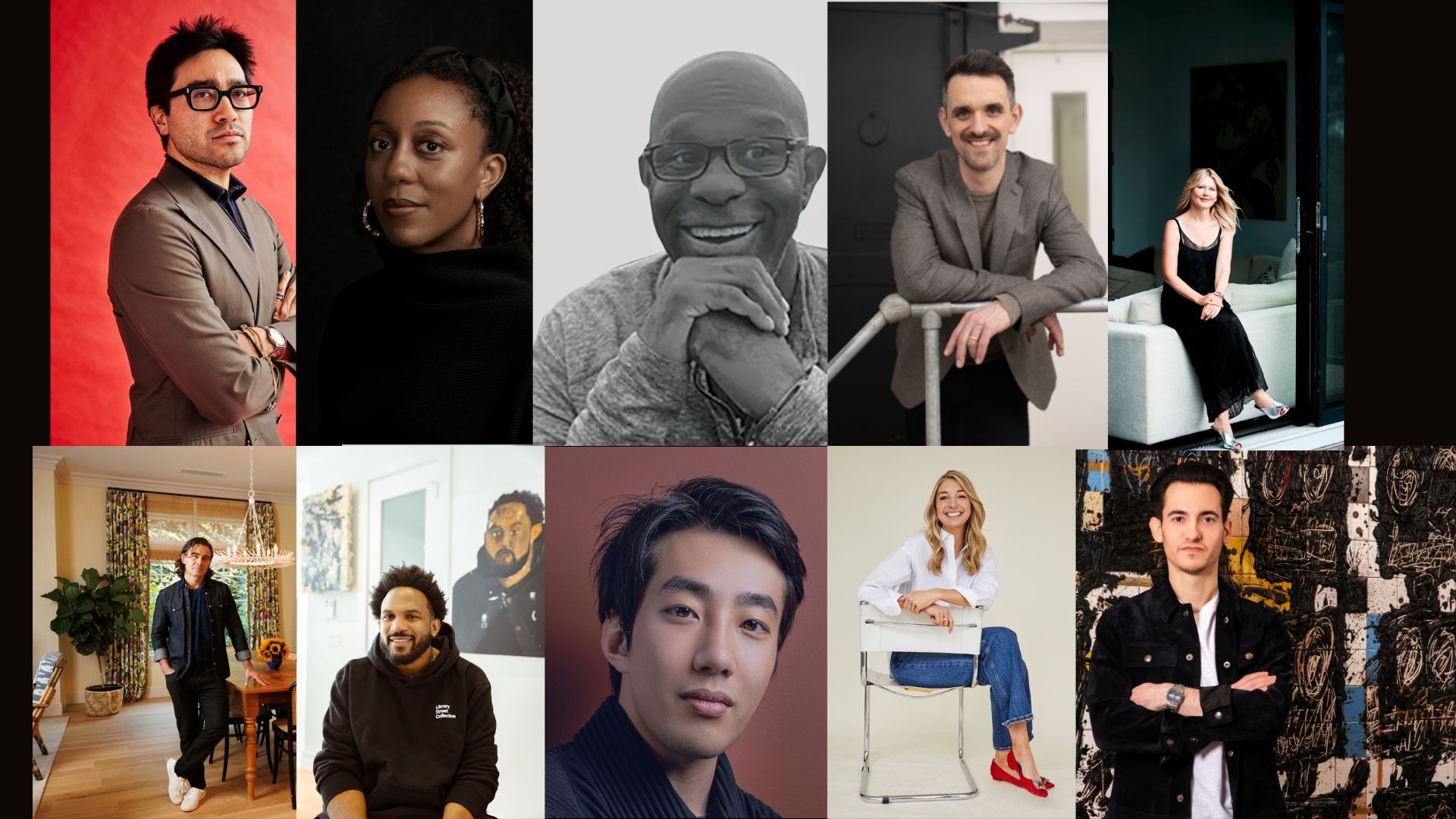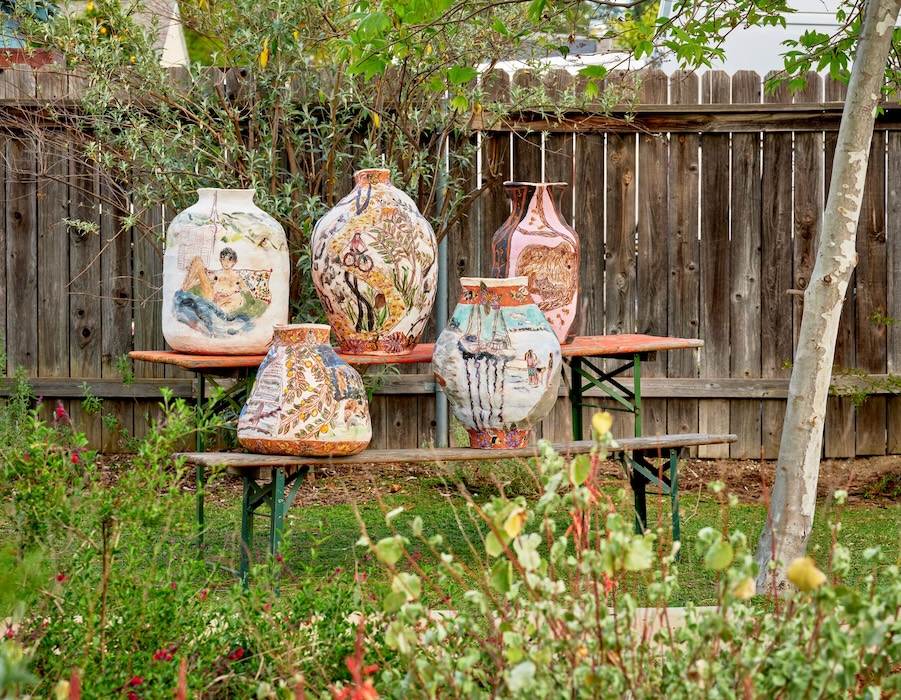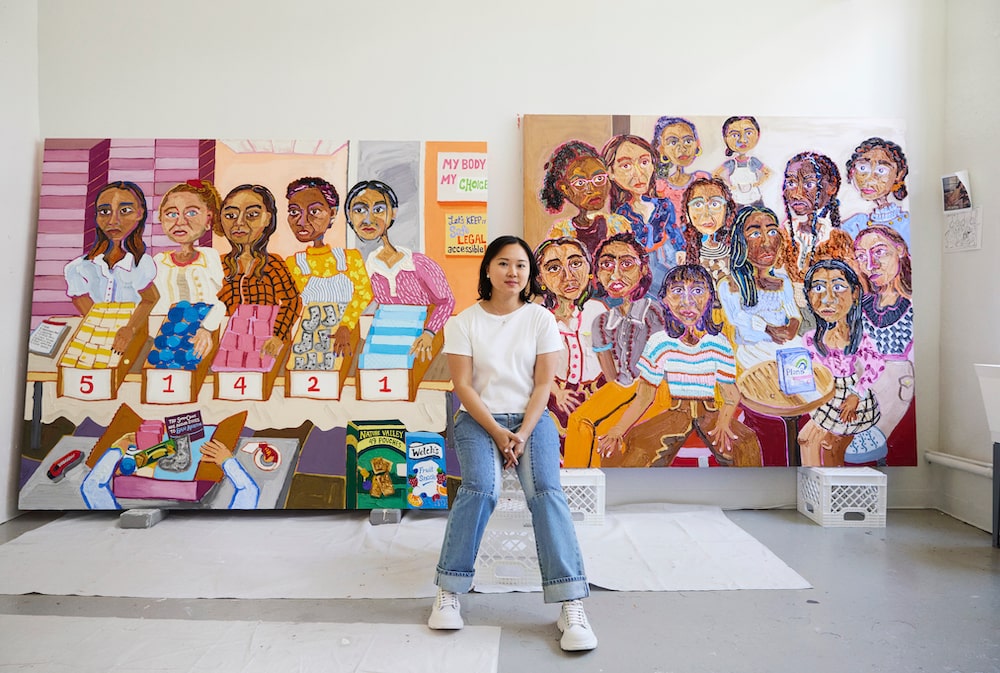Artist Daniel Crews-Chubb is thinking a lot about history. Almost like an archaeologist of visual material, Crews-Chubb mines his mind for snippets of iconic images, sculptures, artifacts, and historic figures from cultures past and present, transforming these moments into memorialized amalgamations of these disparate elements and ideas. Densely layered, abstract yet still figurative, and rife with significance, his works and the marks that comprise these animated compositions are borne from a desire to bring life to complex mythologies and histories of the universe.
Daniel Crews-Chubb Presents New Work in New York
In his latest exhibition of new works, “Out of Chaos,” at Timothy Taylor in New York (September 6—October 19, 2024), Crews-Chubb presents a series of paintings and works on paper that continues upon his fascination with ancient stories and unanswered questions about the universe we inhabit. Without prescribing solutions or answers, his works provide an apt platform for viewers to decide for themselves what they see or how it connects to their own personal stories.
Though there is a singularity to his approach and complex series, a clear connection to Cubism and Abstract Expressionism and modern masters like de Kooning, Pollock, and Picasso is present, through a distinctive and contemporary evolution of process and concept. A refreshing reprieve from the hyperrealist compositions and mass media photographs we are inundated with at virtually all moments of the day, Crews-Chubb forces his viewers to slow down, stop, and think about what is in front of the viewer before quickly moving on to the next visual distraction coming our way.
Whitewall sat down with the artist ahead of his exhibition to talk about the works on view, the evolution of his process and practice as an artist, and what’s forthcoming for the artist globally.
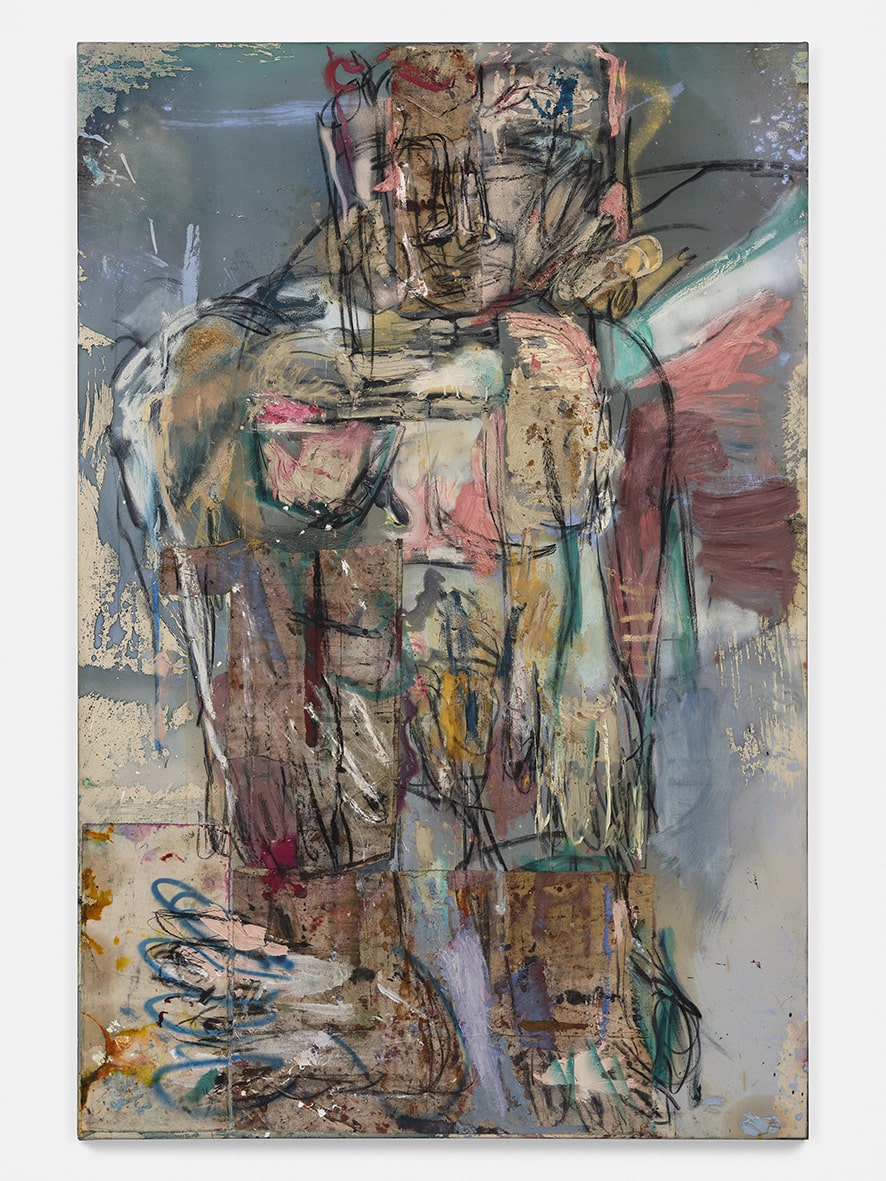 Daniel Crews-Chubb, “Angel (grey blue),” 2024, oil, pigment stick, acrylic, ink, charcoal, spray paint, sand, and collaged fabrics on canvas 94 1⁄2 x 63 1⁄4 inches, courtesy the artist and Timothy Taylor © Daniel Crews-Chubb.
Daniel Crews-Chubb, “Angel (grey blue),” 2024, oil, pigment stick, acrylic, ink, charcoal, spray paint, sand, and collaged fabrics on canvas 94 1⁄2 x 63 1⁄4 inches, courtesy the artist and Timothy Taylor © Daniel Crews-Chubb.
WHITEWALL: What was the starting point for you in creating works for this exhibition at Timothy Taylor in New York?
DANIEL CREWS-CHUBB: I was thinking a lot about the way in which I paint and how the figures do not necessarily depict anyone in particular, and I became more focused on the importance they have in the compositional and structural framework of the painting. In these new large landscapes that form part of the ‘Out of Chaos’ series, there are multiple figures in space. The figures somehow orchestrate the abstract marks through their form and their contorted and mutated bodies which dictate where the mess will be applied – they act as motifs and essentially control the chaos.
Daniel Crews-Chubb’s New Book
“Out of Chaos,” the title of the show and my new book, is drawn from the ancient Greek creation myth and the notion that chaos is a state of undifferentiated matter from which the universe emerged. The paintings are driven by the idea that infinity is an eternal loop between chaos and order and that energy is not destroyed but transformed—a theory that in science is called entropy. When the sun dies and the earth is no more, everything will return to cold chaos, just like our bodies—as temporary vessels—will transfer our energy back into the universe. In the same way, I wanted to make paintings where the figures fade in and out and are more fragmented, almost as if dancing in atmospheric space, swirling around in a melee of limbs – figures not as individuals but as vessels.
WW: There is such a density of material utilized in these works. What compels you to use such an amalgamation of material?
DCC: Sometimes I feel like a sculptor trapped in a painter’s body. Paint for me is just one component. I don’t use brushes really—I’m not a very conventional painter and I often just apply it directly from the tube and mold it with my hands to build up the surface. The collage element of the process actually happened by accident. I kept working on this one painting – it was getting very heavy, and I remember having some torn-up pieces of canvas and other fabric on the studio floor that had drips and stains on that I liked, so I just stuck them on and that was that! It allowed the painting to breathe again; it refreshed the whole thing and gave it balance. Collage became something I would repeat again and again in all of the works. It is a great way to erase and edit very quickly. I also love how different materials react on the surface—like the sketchy charcoal lines next to thick impasto oil paint, the sand, the ink, and the spray paint. I want all of the different elements to be in dialogue on the surface; drawing, sculpting, painting—all on one canvas so that the surface can be just as interesting as the image and composition.
“Sometimes I feel like a sculptor trapped in a painter’s body.”
—Daniel Crews-Chubb
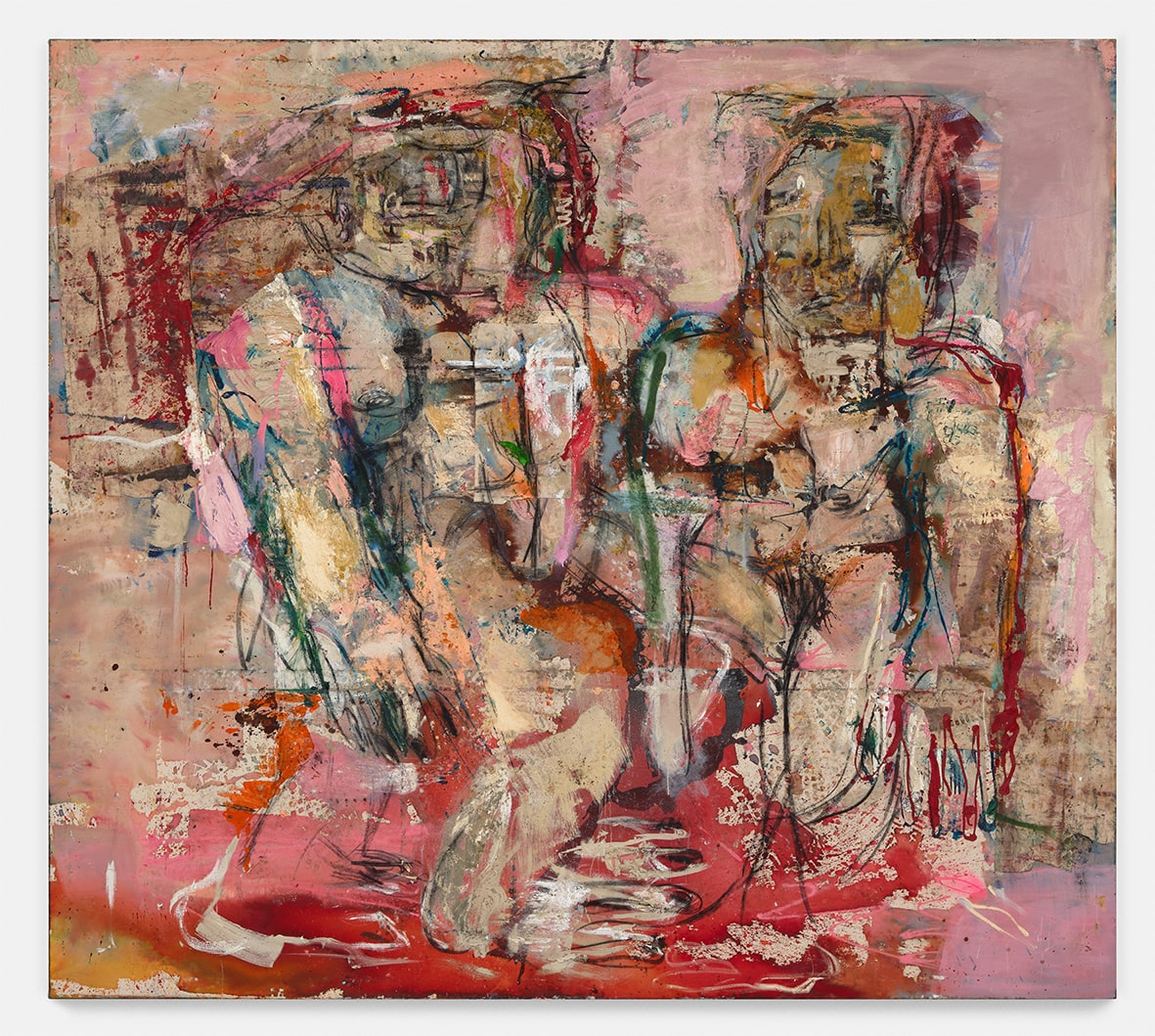 Daniel Crews-Chubb, “Out of Chaos II (pink),” 2024, oil, pigment stick, acrylic, ink, charcoal, spray paint, sand, and collaged fabrics on canvas 106 1⁄4 x 118 1⁄2 inches, courtesy the artist and Timothy Taylor © Daniel Crews-Chubb.
Daniel Crews-Chubb, “Out of Chaos II (pink),” 2024, oil, pigment stick, acrylic, ink, charcoal, spray paint, sand, and collaged fabrics on canvas 106 1⁄4 x 118 1⁄2 inches, courtesy the artist and Timothy Taylor © Daniel Crews-Chubb.
WW: For your canvas works, you seem to have the ability to push the material you are working on to its physical limit with powerful mark-making. How is this tactility modulated when working with a more delicate medium like paper?
DCC: I usually start a series on paper straight after finishing a series on canvas. I think it’s because I can quickly get ideas flowing for the next series of works. I love the immediacy of working on paper, but really I try to treat the canvas works in the same way and not be too precious, treading on them on the floor, spills, drips, dirty edges, that kind of thing. It builds up this grungy, mucky patina that I really like. I use a lot of the same mediums on paper as I do on canvas, but there is a huge difference in scale, so they do have a different feel to them.
WW: You have mentioned that you work on multiple canvases at the same time. Do you have a sense as to where each composition will go, and does it get confusing jumping back and forth between different works simultaneously?
DCC: The way I work is like cooking for a large group of people: each batch (or series) comes out slightly differently. I’ll work on 12 to 15 large works all at once for months and then I’ll have one week, sometimes even one day, when I finish them all together, it’s a nice moment. The work gets to a point where it just kind of informs itself, I like repeating motifs, the figures just keep on reproducing in the studio, like a hybrid new species looking back at me – their creator, like Frankenstein’s monster. I’ll have an idea for a new series like perhaps the next ones should all be whiter or more abstracted or even landscape in profile, then I just go from there.
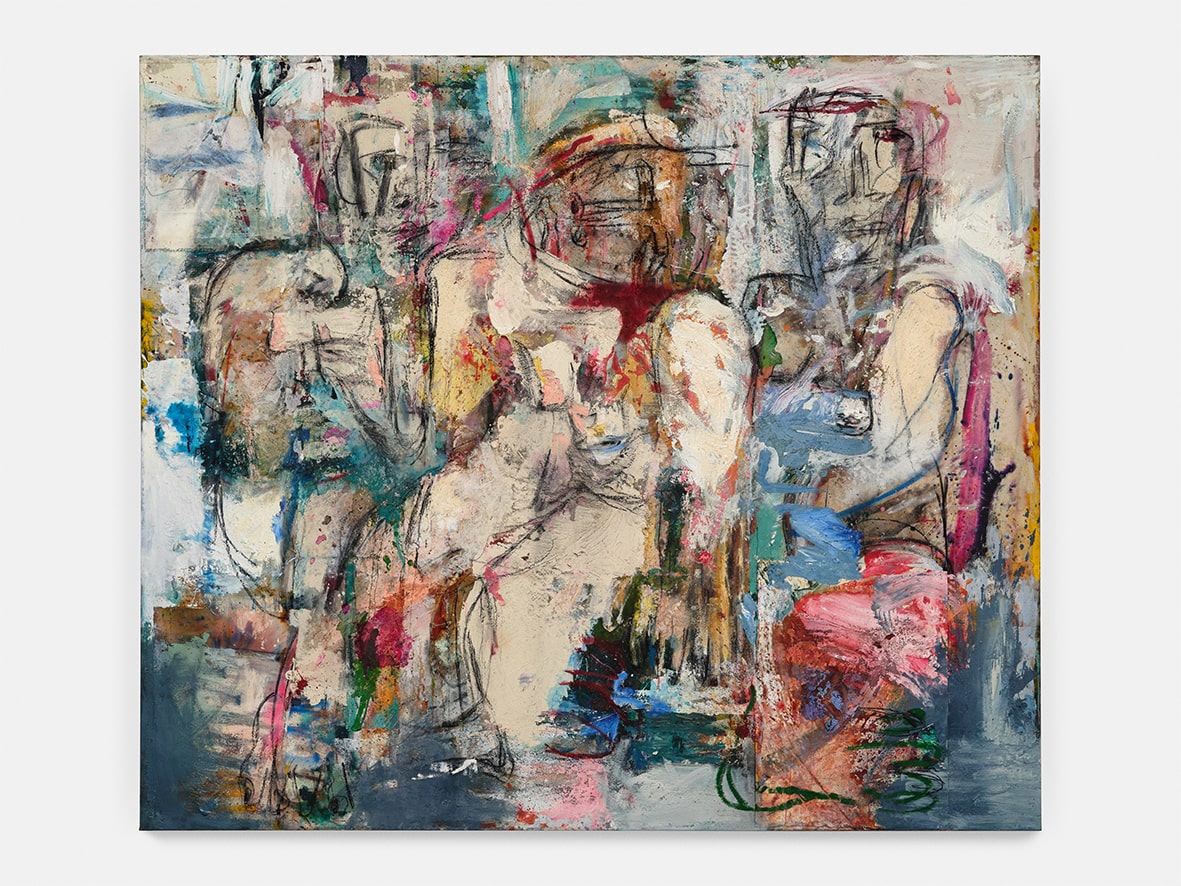 Daniel Crews-Chubb, “Out of Chaos IV,” 2024, oil, acrylic, charcoal, ink, spray paint, sand, pigment stick, and collared fabrics on canvas 98 3⁄8 x 114 1⁄8 inches, courtesy the artist and Timothy Taylor © Daniel Crews-Chubb.
Daniel Crews-Chubb, “Out of Chaos IV,” 2024, oil, acrylic, charcoal, ink, spray paint, sand, pigment stick, and collared fabrics on canvas 98 3⁄8 x 114 1⁄8 inches, courtesy the artist and Timothy Taylor © Daniel Crews-Chubb.
WW: Throughout your career, abstraction has certainly been a component of your output, but here, discernable figuration seems much more distant. Is this an intentional progression you are working towards?
DCC: I see them getting more and more abstracted, which also seems to be the case for many artists I’ve admired throughout history. For example, artists like Picasso, Pollock, de Kooning, and Arshil Gorky all started more figuratively but went searching for a new style. It’s the same for me. I’m finding myself getting more indulged by the materials. I’d like to push the ‘Out of Chaos’ paintings further, make them even less recognizable (as figures), like a cluster of monumental limbs and body parts, viewed from multiple viewpoints, floating around the canvas, like a new form of Cubism.
Daniel Crews-Chubb at the Long Museum in China
WW: Can you tell us a bit about your upcoming show at the Long Museum, opening in just a few weeks?
DCC: I’m really excited about the exhibition as it’s my first major institutional show in China. Many of the new works in the show relate to the “Out of Chaos” series, but I chose to go with ‘Immortals’ as the title as this is an ongoing series and many of the “Immortals” works will be featured in the exhibition on loan. The “Immortals” paintings are based on the icon; singular, emblematic, totemic figures loosely inspired by statues from many different ancient cultures. Michelangelo’s depictions of Roman Gods and Goddesses, to the Greek’s Zeus and Venus, the Hindu Hanuman, the Aztecs and Mayans’ more monstrous deities, and the Egyptian half-man, half-animal Therianthropes have all inspired the paintings over the years. China has such a rich culture and ancient history, so hopefully, links can be drawn to my work and the show will be well received.
“I’m really interested in the human condition and our existential doubts and anxieties.”
—Daniel Crews-Chubb
WW: What is your hope for visitors to come away with after seeing this show?
DCC: I’m really interested in the human condition and our existential doubts and anxieties. It’s one thing we all share—the one absolute truth that connects us all is that we exist in a continuous state and that we will all one day die. I hope the audience might bring themselves into the works, think about the human condition and how, as a species, we are all connected through our reality and our past. As an artist I am fascinated by perception, and the human phenomenon of pareidolia – the tendency to want to find meaning in abstract patterns or random sequences, the search for something familiar in the nonsensical. It’s like seeing faces in rocks or looking up at the clouds and seeing animal shapes forming for a split second before they disappear. As a human being, I have more questions than I do answers, and the same can be said for my works – there are no definites. Instead, I like to think that the more you look at my work the more you see and discover, and that the paintings somehow reveal their secrets slowly each time you revisit them.
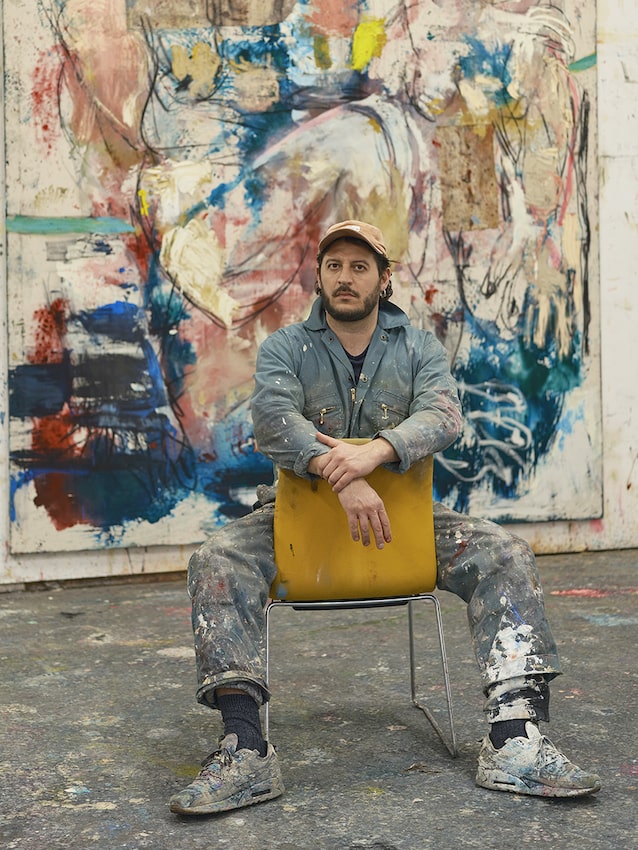 Daniel Crews-Chubb, photo by Daniel Browne, courtesy of the artist and Timothy Taylor Gallery New York.
Daniel Crews-Chubb, photo by Daniel Browne, courtesy of the artist and Timothy Taylor Gallery New York.






